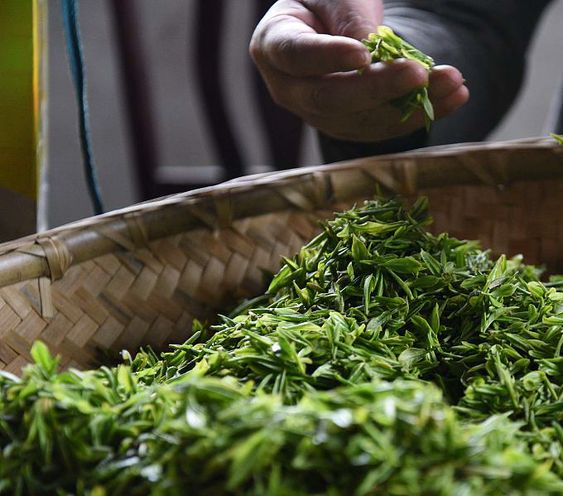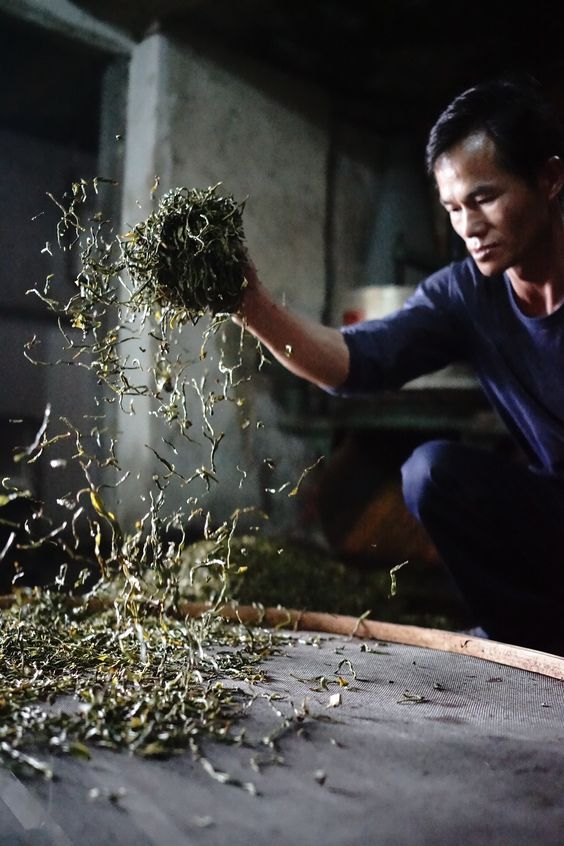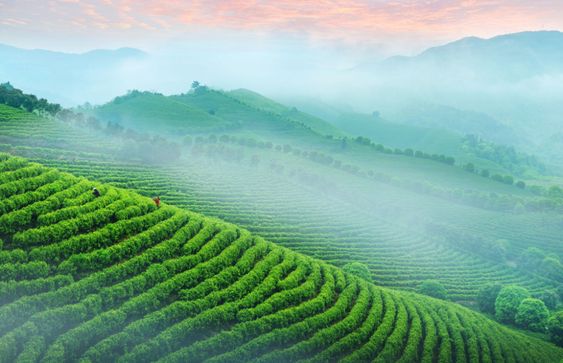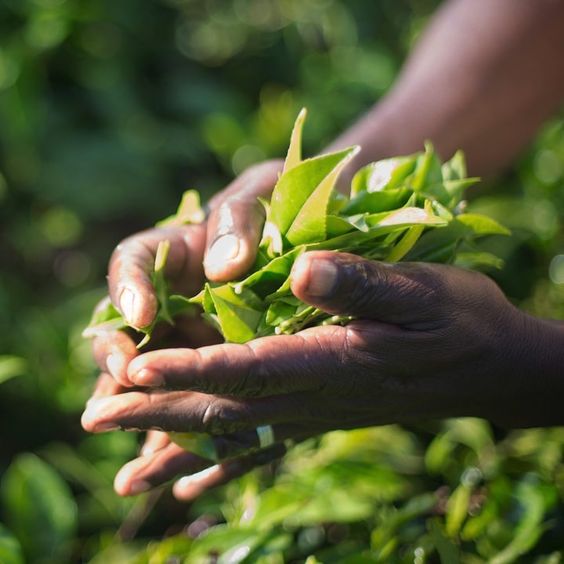Taiping Hou Kui, one of China's famous traditional teas, belongs to the green tea category, produced in Xinming, Longmen and Sankou areas of Huangshan District (former Taiping County) in the northern foothills of Huangshan City, Anhui Province, and has long enjoyed a good reputation as the finest of the pointed teas. The shape of the leaf-wrapped top bud, ‘two knives clamped a gun’ and ‘two leaves hold a bud’ metaphor, buds hide the sharpness of the tip, the top end of the tail cutting, the formation of the two ends of the sharp and thin, ‘Hou Kui two sharp, not scattered, not warped, not rolled edge It is known as ‘Hou Kui with two sharp ends, not scattered, not warped and not curled’.
The strip shape is straight and strong, the colour is green and smooth, the hairs of the Pu Sheng velvet, the aroma of the first bubble is high, the taste of the second bubble is strong, and the taste does not diminish after three or four times of brewing, the fragrance of orchid still exists. Hou Kui tea includes three categories according to its quality, including Hou Kui, Kui Jian and Jian Cha, among which Hou Kui is the best. Hou Kui tea from a variety of claims, one of which is said to be the end of the Qing Dynasty, Nanjing Taiping Chun, Jiangnan Chun and other tea estates, have set up tea in the Taiping production area to buy tea processing tea, transported to Nanjing and other places. Jiangnan Chun Tea House from the tip of the tea picked out young buds and leaves as a high-quality pointed tea supply market, success.
Hou pit tea farmer Wang Kui Cheng in the phoenix tip tea garden chooses fat and young buds and leaves, fine work made Wang Lao Er Kui Jian. Due to the unique style and superb quality of Kui Jian produced in Hou Pit, it was beyond the reach of Kui Jian from other places of origin, and it was specially named ‘Hou Kui’ after the place name of Hou Pit. In 1900, Hou Kui tea was first displayed in Nanjing Nanyang Persuasive Society, and won the excellent prize; in 1915, Hou Kui tea was displayed at the Panama Universal Exposition held in the United States, and won the first-class gold medal and certificate; in 1916, Hou Kui tea was displayed in Jiangsu Commodity Exhibition, and won the first-class gold medal again. In 1955, Taiping Hou Kui was named one of the top ten famous teas in China. On 15 November 2019, Taiping Hou Kui was selected for the catalogue of Chinese agricultural brands.

History of Taiping Houkui
During the reign of Xianfeng in the Qing Dynasty, Zheng Shouqing, the ancestor of Hou Kui, opened a tea plantation on the bank of the Ma Chuan River, where the mountains are high and the soil is fertile, and the clouds and fog are flourishing. Zheng Benkui and the local tea farmers produced flat and straight, fresh and mellow flavour and orchid scent ‘tip tea’, named ‘Taiping tip tea’. It is widely believed that ‘Taiping Jiancha’ is the predecessor of Taiping Hou Kui. The Six Hundred Miles Hou Kui has always represented the highest level of Taiping Hou Kui because it was inherited from Mr Zheng Shouqing himself. In the middle and late Qing Guangxu years, Taiping people in Nanjing, Yangzhou, Wuhan and other places opened tea shop, tea shops, and tea stacks had hundreds of tea, Taiping tea along the river was very popular, Taiping tea and tea merchants flourished for a while.

At that time, Nanjing Jiangnan Spring in the hometown of Ming tea area of the tea buying station, in order to increase the variety of tea, improve product quality and earn higher commercial profits, specifically invited the tip of the tea in the branches of the size of the buds and leaves picked out individually, individually packaged, shipped to Nanjing high-priced sales, by the tea-loving people love, success. Live in Monkey Gang tea farmers Wang Kui Cheng (known as Wang Lao Er), has a wealth of experience in tea production, especially adept at tea processing, and quick thinking, and thus inspired, that rather than picking tea after the tea, not as good as in the harvesting of fresh leaves began to pick and choose a good system, so that in the altitude of 750 metres in the tip of the Phoenix, a high mountain tea plantation called Splash Cesspit carefully selected and strong and quite a bud and two leaves, after careful production, the production of dried tea Good specifications, high quality, known as ‘Wang Lao Er Kui Jian’. As the quality of this tea is at the top of pointed tea, the first creator was also named Kui Cheng, and it was produced in the area of Monkey Pit and Monkey Gang in Taiping County, so this tea was called ‘Taiping Hou Kui’.
In 1915, under the recommendation of Liu Jingzhi and Su Xidai of the Taiping Chamber of Commerce, Fang Nanshan travelled to the United States to participate in the Panama Exposition held in San Francisco with Hou Kui tea. Hou Kui tea won the first-class gold medal for its unique quality. From then on, Taiping Hou Kui tea went out of the country. However, the poverty and weakness of the old China missed the development of Taiping Hou Kui's excellent timing, so decades later Taiping Hou Kui was annihilated without a trace. In 1913, the listing was purchased, and in 1935, the production of Taiping Hou Kui reached 500kg, then it declined all the way down, and in 1949, the production dropped to 95kg.
After the founding of the country, although the status and reputation of Taiping Hou Kui have improved, as the inner tribute tea enjoys a special honour and courtesy, the system of the planned economy has seriously constrained the development of Taiping Hou Kui, the annual production of Taiping Hou Kui has been hovering around 500 kilograms.
Distribution of production area
Taiping Hou Kui is produced in the Xinming area of Huangshan Mountain (former Taiping County) in the northern foothills of Huangshan City, Anhui Province, which is low-temperature and humid, with fertile soil and cloud cover. The main production areas are located in Monkey Pit, Monkey Gang and Yan Jia in Sanmen Village, Xinming Township. Especially, the tip tea plucked from the high mountain tea plantation in Monkey Pit is of the best quality. The tea plantations are all located in the middle and low mountains above 350 metres, with black sandy loam soil, deep soil layer and rich in organic matter. The terrain of the tea plantations is mostly facing north and south, located in the semi-shaded and semi-yang ridges of the mountain slopes. The place of production is low temperature and humid, the soil is fertile and alive and covered with clouds and mist. Growing environment at an altitude of 100-300 metres, the average annual temperature of 15 ℃, more than 300 meters above sea level, less than 14 ℃, the average temperature in July 28.2 ℃, the average temperature in January 2.1 ℃, cool and mild spring and autumn temperatures, the average temperature in April and October, respectively, 15.4 ℃, 16.7 ℃.

Illumination
The total annual solar radiation is 506.18 kJ/cm2, and the solar radiation during the period when the average daily temperature is ≥0℃ is 369.69 kJ/cm2, accounting for 73% of the total annual radiation. The annual sunshine hours are 2,000-2,230 hours, and the annual sunshine percentage is around 50%, with relatively abundant light energy resources.
Precipitation
The average annual precipitation is between 1,200-1,400 mm. According to statistics, of the 25-year average annual precipitation, 28.9% is in spring, 41.1% in summer, 19.4% in autumn and 10.6% in winter. The average annual number of days of precipitation is 125.6 days, and the perennial relative humidity is 80%, with a dryness of 0.8 or less, making it a humid zone.
Soil
Soil types are complex. The middle mountainous area (inner mountainous area) is mainly yellow-brown soil, i.e. common yellow-brown soil and mountain yellow-brown soil, the parent material of which is mostly granite, granite gneiss and hornblende gneiss, with a soil depth of more than 1.5 metres, high content of organic matter, and good fertility and permeability of the soil, with a pH of 4.8-5.5; the outer hillock area (outer mountainous area) is dominated by the yellow-brown soil that is differentiated into the parent material of the Lower Shu system, which is the main soil type of the mountain. Although the soil layer is thick, the ploughing layer is shallow, the texture is sticky and heavy, and the bottom layer is often an impermeable clay disc layer, with poor fertility and permeability, pH5-6.5; followed by a small portion of the riverbanks and valleys, mostly alluvial soils, that is, sandy loam (Wusha Soil), the soil layer is deep and thick, the fertility is high, the permeability is good, generally high-yield tea plantation area.
Quality Characteristics
The appearance of Taiping Hou Kui has two leaves holding buds, flat and straight, naturally spreading, with white hairs hidden, and is known as ‘Hou Kui with two sharp ends, not scattered, not warped, not curled edge’. The leaf colour is pale green and uniformly moist, the leaf veins are green with hidden red, commonly known as ‘red silk thread’; the fragrance of the orchid is high and refreshing, the taste is mellow and sweet, the soup colour is clear and green, the bottom of the leaf is tender green and even bright, and the buds and leaves are fat and strong.
The colour, aroma, taste and shape of Taiping Hou Kui are all unique: the whole body is covered with white hairs, which are contained but not exposed, and when brewed in a cup, the buds and leaves are formed into dosas, either hanging or sinking. Its taste is fragrant, mellow and refreshing, with an endless aftertaste, with the meaning of ‘the first bubble is fragrant, the second bubble is strong, and the third and fourth bubbles are still fragrant’.
Taiping Monkey King's finished tea is straight, slightly pointed at both ends, flat and even, fat and strong, with white hairs all over the body, luxuriant but not obvious, containing but not exposed, pale green in colour, the main veins of the leaves are liver-coloured, like olives; into the cup to brew, the buds and leaves unfolded slowly, released into bloom, the two leaves embrace a bud, or hanging or sinking; the tea broth is clear green, with a high and refreshing aroma.
Picking Standard
The fresh leaves of Taiping Hou Kui are packed with special care. Before and after the rainy season, when 20% of the buds grow to the first three leaves of a bud, the garden can be opened. After that, a batch is picked in 3~4 days, and the picking stops at the beginning of summer, and the pointed tea is made after the beginning of summer. Picking standards for a bud three leaves at the beginning of the show, and strictly do the ‘four picks’: a pick mountain, pick high mountains, shady mountains, cloud-covered tea mountain; two pick series, pick lush persimmon tea varieties of tea bushes; three pick branches, pick thick, straight shoots; four pick tip, picking back the fresh leaves should be ‘pick tip The fourth pick tip, the harvested fresh leaves should be ‘pick tip’, that is, fold down a bud with two leaves ‘tip’, as the raw material of the production of Hou Kui. The ‘tip’ requires the buds and leaves to be fat and strong, even and neat, moderately old and tender, with the leaf margins rolled back, and the length of the bud tips and leaf tips are aligned to ensure that the tea can form the appearance of ‘two leaves holding a bud’.
When picking the tip, the buds and leaves are too big, too small, thin, weak, curved, pale in colour, purple buds, pairs of clamped leaves, pests and diseases (i.e. ‘eight don'ts’). ‘Pick the tip’, the elimination of buds and leaves, single pieces, are made “Kui piece”. Generally, pick in the morning, pick at noon, and the day system is finished.

Taiping Hou Kui picking should be carried out on sunny days, and generally not picked on rainy days. The process of ‘picking tips’ is also the process of spreading fresh leaves. The short time spreading is a kind of light withering, so that a small amount of water loss, is easy to kill the green, but also conducive to the transformation of the contents, the formation of the aroma and flavour of the Hou kui play a certain role.
Manufacturing process
Taiping Hou Kui is manufactured in four processes: greening, baking, foot baking and re-roasting.
Killing
Use a 70cm diameter barrel pot with smooth and clean walls. Use charcoal as fuel to ensure stable pot temperature. The temperature of the pot should be about 110℃, and the amount of leaves to be thrown into each pot should be 75-100g. Stir-frying requirements ‘with a light, clean, shake open’, lasted 2-3 minutes. Before the end of the killing, it should be appropriate to straighten. Killing leaves should be intact, connected with stalks and leaves, naturally straight, and the leaf surface should be stretched.
Gross baking
According to a killing pot with four cages, the fire temperature is 100 ℃, 90 ℃, 80 ℃, 70 ℃. Killing leaves spread on the top of the baking, gently pat the top of the baking, so that the leaves spread evenly and flat. Appropriate loss of water after turning to the second baking, the first buds and leaves spread evenly, and finally gently press the tea leaves with your hands, so that the leaves are flat and hold the buds, the shape is straight, you need to bake the side of the press. The third baking temperature is slightly lower. Still have to bake while pressing. When turned to the fourth baking, the leaf has been dry and crisp and can not be pressed. To six or seventy per cent dry, under the drying and cooling.
Foot baking
The amount of leaves thrown is about 250 grams, a fire temperature of about 70 ℃, to use the brocade soft cushion side of the baking side of the press, fixed tea shape. After 5-6 times of baking, about 90% dry, under baking and spreading.
Re-roasting
It is also called playing the old fire, the amount of leaves cast is about 1900g. The fire temperature is about 60℃, turn over while roasting. Do not press the pressure. Foot dry after the hot tube, tube pad Ruo leaves, to improve the Hou Kui aroma, so there is ‘tea is grass, Ruo is a treasure’ said. To be cooled tea, plus cover welding seal. [8]
Grade Standard
Its quality is according to the traditional method: Hou Kui for the top grade, kui tip, followed by Gongjian, Tianjian, Dijian, Renjian, and pointed, Yuanjian, curved tip and other traditional tip tea.
The products are divided into five grades: the best, special grade, first grade, second grade and third grade.
Extremely: the appearance of flat and straight, majestic and sturdy, two leaves hold a bud, uniform, hair more than not show, pale green and uniformly moist, part of the main veins dark red; soup colour green and bright; aroma fresh and high, with lasting orchid flavour; taste fresh and mellow, sweet aftertaste, unique ‘monkey rhyme’, the bottom of the leaf is young and uniform, fat, into the flower, tender yellow-green and bright.
Special grade: flat and sturdy in appearance, two leaves holding a bud, even, more than one hair does not show, pale green and uniformly moist, part of the main vein dark red; soup colour is tender green and bright, aroma is fresh and fresh, orchid fragrance is longer; taste is fresh and mellow, aftertaste is sweet, with ‘monkey rhyme’; the leaf bottom is tender and uniform and plump, into the flower, young yellow-green uniformly bright.
First grade: flat and solid in appearance, two leaves holding a bud, even and neat, not obvious, pale green more uniformly moist, part of the main vein dark red; soup colour tender yellow-green and bright; the aroma is clear and high, with orchid aroma; the taste is fresh and refreshing with a sweet aftertaste, with ‘monkey rhyme’; leaf bottom is tender and even into a flower, yellow-green and bright.
Grade 2: flat shape, two leaves holding a bud, a small number of monolithic, still even, no show, green; soup colour yellow-green and bright; aroma with orchid fragrance; taste mellow and sweet; leaf bottom is still tender and even, into a flower, a small number of monolithic, yellow-green and bright.
Grade 3: the shape of two leaves holds a bud, a few warped scattered, a small number of broken, there is hair, less uniform, still green; soup colour yellow-green is still bright; aroma pure fragrance; taste mellow; the leaf bottom is still tender and less uniform, into a flower, a small number of broken, yellow-green bright.
